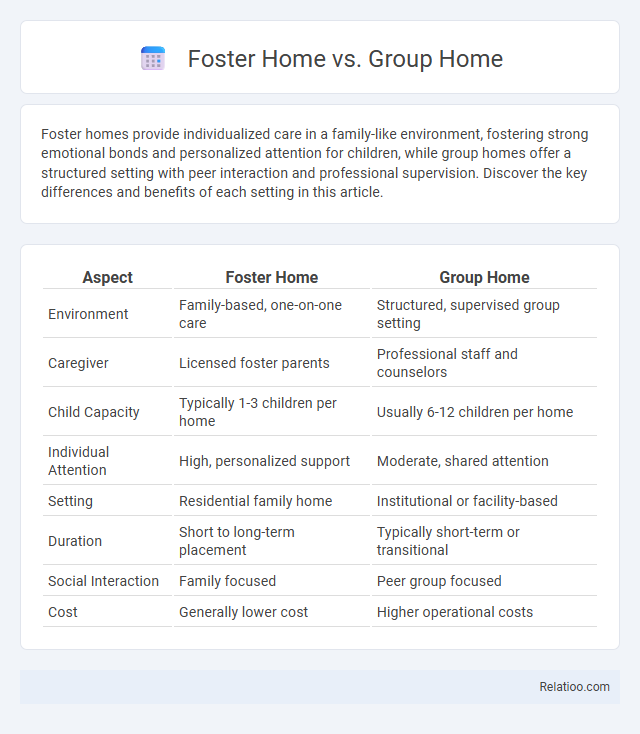Foster homes provide individualized care in a family-like environment, fostering strong emotional bonds and personalized attention for children, while group homes offer a structured setting with peer interaction and professional supervision. Discover the key differences and benefits of each setting in this article.
Table of Comparison
| Aspect | Foster Home | Group Home |
|---|---|---|
| Environment | Family-based, one-on-one care | Structured, supervised group setting |
| Caregiver | Licensed foster parents | Professional staff and counselors |
| Child Capacity | Typically 1-3 children per home | Usually 6-12 children per home |
| Individual Attention | High, personalized support | Moderate, shared attention |
| Setting | Residential family home | Institutional or facility-based |
| Duration | Short to long-term placement | Typically short-term or transitional |
| Social Interaction | Family focused | Peer group focused |
| Cost | Generally lower cost | Higher operational costs |
Understanding Foster Homes vs Group Homes
Foster homes provide individualized care by trained foster parents who offer a family-like environment for children needing temporary support. Group homes serve multiple youth simultaneously, staffed by professionals in a structured setting focused on behavioral or emotional needs. Your choice between foster homes and group homes depends on the level of personalized attention and the child's specific requirements for stability and support.
Key Differences Between Foster and Group Homes
Foster homes provide individualized care for children in a family-like setting, typically with one or two foster parents offering personalized attention and stability. Group homes accommodate multiple children or adolescents, staffed by professional caregivers in a structured environment promoting social interaction and support for behavioral or emotional needs. Understanding these key differences helps you choose the best setting tailored to your foster care goals and the child's specific requirements.
Care Structures in Foster Homes and Group Homes
Care structures in foster homes typically provide one-on-one or family-style attention, with foster parents offering personalized support and stability tailored to Your child's individual needs. Group homes, by contrast, operate with professional staff managing multiple children in a shared residential setting, emphasizing structured routines and social development among peers. Understanding these differences helps determine the best care environment, balancing personalized caregiving with communal living support systems.
Types of Children Served
Foster homes primarily serve children who need temporary family-based care due to neglect, abuse, or family crisis, providing a stable, nurturing environment. Group homes accommodate children with more intensive emotional, behavioral, or developmental challenges requiring specialized therapeutic support and structured living. Foster parenting involves caregivers trained to support children from diverse backgrounds, often including those with trauma, disabilities, or special needs, ensuring individualized care tailored to each child's unique circumstances.
Licensing and Regulatory Requirements
Licensing and regulatory requirements for foster homes, group homes, and foster parenting vary significantly based on jurisdiction but generally include rigorous background checks, safety inspections, and compliance with state child welfare agencies. Foster homes require individual licensing to ensure a safe, family-style environment, whereas group homes operate under facility licenses with regulations addressing staff qualifications and minimum staff-to-child ratios. Foster parenting mandates ongoing training and adherence to child welfare standards, with oversight to support foster parents in meeting the emotional and developmental needs of children in care.
Daily Life and Support Systems
Foster homes offer a family-like daily environment with personalized care, where children live with foster parents who provide consistent emotional support and supervision. Group homes provide structured routines and social opportunities in a residential setting, staffed by trained professionals available 24/7 to address behavioral and therapeutic needs. Foster parenting emphasizes individualized attention within a nurturing household, supported by social workers, counseling services, and community resources to promote stability and long-term well-being.
Emotional and Social Impact on Children
Foster homes provide individualized emotional support and stable family environments that help children build secure attachments and social skills. Group homes, often staffed by professionals, offer structured peer interactions but may lack personalized attention, potentially causing challenges in forming deep emotional bonds. Foster parenting involves a dedicated caregiver role that fosters consistent nurturing, promoting resilience and healthy social development in children experiencing trauma or displacement.
Placement Process and Eligibility
The placement process for foster homes typically involves a thorough background check, home study, and training to ensure Your safety and readiness to care for a child, while group homes operate under state licensing with professional staff managing daily routines for multiple children. Foster parenting eligibility requires meeting specific criteria such as age, income stability, and emotional preparedness, whereas group homes accept children based on therapeutic or behavioral needs, with less emphasis on individual foster parent qualifications. Understanding these processes and eligibility standards helps You determine the best environment for a child's placement and ongoing support.
Pros and Cons of Foster Homes vs Group Homes
Foster homes offer a family-like environment with personalized care and attention, promoting emotional stability and individual growth, but may vary in quality depending on the foster parents' training and resources. Group homes provide professional supervision and structured routines for children with higher needs or behavioral issues, yet can lack the intimate, nurturing atmosphere found in foster homes and may result in less individualized support. The choice between foster homes and group homes hinges on the child's specific emotional, behavioral, and developmental needs, with foster parenting fostering deeper familial bonds but sometimes limited by resource constraints.
Choosing the Right Residential Placement
Choosing the right residential placement involves evaluating the unique needs of the child, where foster homes provide individualized care in a family setting, and group homes offer structured environments for children requiring more supervision. Foster parenting emphasizes building close, stable relationships between caregivers and children, which supports emotional development and a sense of security. Decision-making should consider factors such as the child's behavioral needs, support systems available, and long-term well-being to ensure the most effective placement.

Infographic: Foster Home vs Group Home
 relatioo.com
relatioo.com